Nova série
para circulação com moedas de cupro-níquel, bronze-alumínio e prata. A lei
no. 3454 de 6 de janeiro 1918 autorizou cunhar moeda divisionária de níquel
e cobre. O decreto no. 3545 de 2 de outobro 1918 abriu um crédito de
10.000.000 réis para a cunhagem de novas moedas de 20 e 50 réis de
níquel e para modificar as moedas de prata. Em seguida foram cunhadas en
níquel moedas de 20, 50, 100, 200 e 400 réis. As moedas novas de 500 e 1000
réis foram mandado cunhar pela lei no. 4783 de 31 de dezembro 1923 até a
importância de 15.000.000.000 réis. A mesma lei autorizou cunhar moedas de
2000 réis de prata até 20.000.000.000 réis. Em
1914 foi elaborado um ensaio para uma moeda de 2000 réis com a figura da
abundância que acabou utilizada nas
moedas de 500 e 1000 réis desta série. O gravador foi João da Cruz Vargas (sigla
JV nas moedas de 500 até 2000 réis). As características das moedas de 500,
1000 e 2000 réis foram estabelecidas pelo decreto no. 16.409 de 12 de março
1924. Durante a primeiro guerra mundial o Brasil aproveitou bastante a
oportunidade de grandes e rápidos negócios com preços elevados dos produtos
exportáveis. Mas depois da guerra o Brasil entrou numa crise, os preços dos
produtos, especialmente o preço do café, caíram e o mil réis começou a
desvalorizar. Tambem a quebra da bolsa de Nova York, em 1929, teve enorme
repercussão sobre a economia Brasileira e o valor do mil réis. Por isso não
mais for possivel de cunhar en prata as moedas de 500 e 1000 réis, também
porque o preço da prata começou a subir. Só as moedas de 2000 réis foram
cunhadas en prata mas com liga diferente, o teor caiu de .900 para .500.
Durante a circulação a cor da moeda mudou para uma cor mais escuro,
especialmente nas partes mais altas coma a face da mulher. Por isso a moeda
ganhou nomes differentes em diversas regiões como fininha, banhadinhas,
Isabelinha, meia prata, cara suja, Catarina, mixuruca e chachorinha. Nessa
epoca cresceu bastante a falsificação das moedas, existam muitas moedas
falsas desta epoca. Interessantes são as moedas falsas de 500 réis com as datas 1926 e 1929.
Duas datas que nunca foram cunhadas en original na casa da moeda. No caso da
moeda de 500 réis de 1929 falsa tem informações interessantes. Em Ribeirão
Preto um torneiro foi preso porque a sua mulher começou gastar uma grande
quantidade de moedas de 500 réis o que chamou a atenção da policia. O
advogado do torneiro declarou que o cliente dele não falsificou nada porque
moedas de 500 réis com a data 1929 nunca foram cunhadasa oficialmente.
Depois de consultar o Tesouro Nacional e a Casa da Moeda o torneiro foi
liberado porque "nem o Tesouro Nacional e nem a Casa da Moeda haviam
autorizado ou fabricado as referidas moedinhas". O torneiro só foi acusado
de simular dinheiro e não de falsificar dinheiro. Na época a rua da oficina
do torneiro ficou conhecida como "rua do Tesouro"2.
Nieuwe serie voor de circulatie met munten gemaakt van cupro-nikkel,
aluminium-brons en zilver. Wet nr. 3454 van 6 januari 1918 autoriseerde de
muntslag van kleingeld gemaakt van nikkel en brons. Decreet nr. 3545 van 2
oktober 1918 stelde een bedrag beschikbaar van 10.000.000 réis om nieuwe
munten aan te maken van 20 en 50 réis en om nieuwe munten in te voeren van
2000 réis. Als vervolg op deze wet zijn er nieuwe nikkelen pasmunten
geslagen ter waarde van 20, 50, 100, 200 en 400 réis. De aanmunting van
nieuwe munten van 500 en 1000 réis werd voorgeschreven volgens wet nr. 4783
van 31 december 1923 tot een bedrag van 15.000.000.000 réis. Dezelfde wet
regelde de muntslag van zilveren munten van 2000 réis tot een bedrag van
20.000.000.000 réis. In 1914 werd reeds een ontwerp gemaakt voor een munt
van 2000 réis met de afbeelding van abundantia. Deze afbeelding werd
gebruikt op de munten van 500 en 1000 réis uit deze serie. De graveur van de
stempels voor de munten van 500, 1000 en 2000 réis was
João da Cruz Vargas, initialen JV op deze munten. De ontwerpen voor de
munten van 500, 1000 en 2000 réis werden vastgelegd per decreet nr. 16.409
van 12 maart 1924. Gedurende de eerste wereldoorlog had Brazilië, net als de
overige landen die niet in oorlog waren, geprofiteerd van de gegroeide
export naar het buitenland met hoge prijzen voor de producten. Na de oorlog
kwam Brazilië echter in een crisis terecht omdat de prijs van de producten
dramatisch was gezakt waaronder de prijs van koffie. Hierdoor, en door
binnenlandse politieke strubbelingen, begon de Braziliaanse munt, de mil
réis, in waarde te dalen ten opzichte van het Britse pond en de Amerikaanse
dollar. Ook het instorten van de beurs van New York in 1929 had desastreuze
gevolgen voor de Braziliaanse economie en de waarde van de mil réis. Daarom
bleek het niet meer mogelijk om zilveren munten te slaan van 500 en 1000
réis maar werden deze geslagen van een legering van aluminium-brons, mede
omdat de prijs van zilver begon te stijgen. Alleen de munten van 2000 réis
werden nog van zilver geslagen maar van een gewijzigd gehalte. Het gehalte
werd verlaagd van 900/1000 naar 500/1000. Nadat deze zilveren munten enige
tijd in roulatie waren begon op de hogere delen, voornamelijk het gezicht
van de vrouw, de zilverkleur te verdwijnen en werden de munten daar
donkerder. De munten kregen daardoor in geheel Brazilië bijnamen als fijntje,
zilverbadje, Isabelatje, half zilver, vies gezicht, Catarina, armzalige en
teefje. In deze tijden van crisis nam de valsmunterij een hoge vlucht, uit
de periode 1920-1940 bestaan een groot aantal vervalsingen van bijna alle
munttypen en jaartallen. Interessant zijn de munten van 500 réis met de data
1926 en 1929. Dit zijn allen contemporaine vervalsingen, deze jaren zij
nooit officieel geslagen in het Braziliaanse munthuis. In het geval van de
van 500 réis met het jaartal 1929 is enige aanvullende informatie
voorhanden. In Ribeirão Preto werd een loodgieter gearresteerd omdat zijn
vrouw grote hoeveelheden munten van 500 réis uit gaf wat de aandacht van de
lokale politie begon te trekken. De advokaat van de loodgieter verklaarde
echter dat zijn cliënt niets had vervalst omdat er nooit officieel munten
van 500 réis met het jaartal 1929 waren geslagen. Ook verklaarde de
thesaurier en het munthuis dat zij nooit dergelijke munten hadden geslagen
of daartoe opdracht hadden gegeven. De loodgieter werd daarop niet
beschuldigt van valsmunterij maar van het imiteren van geld en mocht het
proces in vrijheid afwachten! In de tijd dat zich dit afspeelde werd de
straat waar de loodgieter zijn bedrijf had bekend onder de naam "straat van
de thesaurier".
New series of coins for circulation purposes made of copper-nickle, aluminium-bronze
and silver. Law nr. 3454 of januari 6, 1918 authorised the coinage of small
change made of nickle and bronze. Decree nr. 3545 of october 2, 1918
liberated the sum of 10.000.000 réis to strike new coins of 20 en 50 réis
and to design new coins of 2000 réis. As a result of these laws new coins
made of nickle were struck with the values of 20, 50, 100, 200 and 400 réis.
The coinage of new coins of 500 and 1000 réis was regulated by law nr. 4783
of december 31, 1923 until a sum of 15.000.000.000 réis. This same law
regulated the coinage of silver coins of 2000 réis until a sum of
20.000.000.000 réis. In 1914 a design was made for a coin of 2000 réis with
the image of abundantia. This image was now used on the coins of 500 and 1000 réis
of this series. The engraver of the dies for the coins of 500, 1000 and 2000
réis was
João da Cruz Vargas, initials JV on these coins. The design for these coins
of 500, 1000 and 2000 réis was regulated by decree nr. 16.409 of march 12,
1924. During the first world was Brazil, as other countries not in war, had
benefited of the trade of much wanted materials and goods at high prices and
high quantities. After the war however Brazil fell into a deep recension
because of much lower prices and the decline and fall of the coffee market.
Because of this and internal political trouble the Brazilian mil réis began
to desvalorize. Also the the crash of the New York stock exchange in 1929
had a catastrophical outcome on the Brazilian economy and the value of the
mil mil réis. Because of this it was no longer possible to strike silver
coins of 500 and 1000 réis but these coins were now struck in an alloy of
aluminium-bronze, also because the price of silver began to rise. Only the
coins of 2000 réis were struck in silver but with a lower silver content,
500/1000 silver instead of 900/1000 silver. During circulation the silver
colour on the higher parts of these coins, for example the face of the
womans head, turned to a darker colour. This was the reason that the coins
received nicknames refering to the lower alloy of the coins. Some of the
nicknames were fine one, silver dip, Isabela, half silver, dirty face,
Catarina, poor thing and bitch. In these times of crisis the counterfitting
of coins reached an all time high. During the years 1920-1940, almost every
type of coin and every date was copied by counterfitters. Interesting are
the coins of 500 réis with the dates
1926 en 1929. All the coins with these dates are counterfit, these dates
were never struck in the official Brazilian mint. In the case of the 500
réis coin with the date 1929 there is some further information about the
counterfitter. In the city of Ribeirão Preto a plumber was arrested
because his wive spend large quantities of 500 réis coins wich attracted the
curiousity of the local police. The plumbers lawyer however stated that his
client did not counterfit anything because 500 réis coins with the date 1929
were never officialy minted. Also the treasury department and the Brazilian
mint declared that they had never struck these dates. Because of this the
plumber was only accused of imitating coins and not falsificating coins. He
was liberated and was permited to await the outcome of the trial as a free
man! During that time the street where the plumber had his workshop, became
known as "street of the treasurer". |
20
réis cupro-níquel (75% cobre e 25% níquel), peso
2,00 gr.
Anv: Cabeça de uma
mulher
personificando
Brasil dentro colar de 21
estrelas.
Rev: 20 RÉIS dentro
florões stilados. Texto: REPUBLICA DOS ESTADOS UNIDOS DO BRASIL e data.
20 réis koper-nikkel (75% koper en 25% nikkel), gewicht
2,00 gr.
Vz: Vrouw
voorstellende
Brazilië met 21
sterren om het
hoofd.
Kz: 20 RÉIS binnen
gestileerde
bloemversiering. Tekst: republiek van de
verenigde staten
van Brazilië en jaartal.
20 réis copper-nickel (75% copper and 25% nickle), weight
2,00 gr.
Obv: Woman
representing Brazil
with 21 stars
around the head
Rev: 20 RÉIS in
flowery shaped
ornaments. Text: republic of the
united states of
Brazil and date. |
 |
Data: |
Quantidade: |
1918
1919
1920
1921
1927
1935
|
372.500
2.870.000
825.000
1.020.000
52.500
100 |
Peso:
Gewicht: 2,00 gr.
Weight:
|
50
réis cupro-níquel (75% cobre e 25% níquel), peso
3,00 gr.
Anv: Cabeça de uma
mulher
personificando
Brasil dentro colar de 21
estrelas.
Rev: 50 RÉIS dentro
colar de pérolas. Texto: REPUBLICA DOS ESTADOS UNIDOS DO BRASIL e data.
50 réis koper-nikkel (75% koper en 25% nikkel), gewicht
3,00 gr.
Vz: Vrouw
voorstellende
Brazilië met 21
sterren om het
hoofd.
Kz: 50 RÉIS in een
cirkel van parels. Tekst: republiek van de
verenigde staten
van Brazilië en jaartal.
50 réis copper-nickel (75% copper and 25% nickle), weight
3,00 gr.
Obv: Woman
representing Brazil
with 21 stars
around the head
Rev: 50 RÉIS in a
circle of pearls. Text: republic of the
united states of
Brazil and date. |
 |
Data: |
Quantidade: |
1918
1919
1920
1921
1922
1925
1926
1931
1935 |
558.000
558.000
72.000
682.000
176.000
128.000
194.000
20.000
100 |
Peso:
Gewicht: 3,00 gr.
Weight: |
100
réis cupro-níquel (75% cobre e 25% níquel), peso
5,00 gr.
Anv: Cabeça de uma
mulher
personificando
Brasil dentro colar de 21
estrelas.
Rev: 100 RÉIS
dentro colar de pérolas. Texto: REPUBLICA DOS ESTADOS UNIDOS DO BRASIL e
data.
100 réis koper-nikkel (75% koper en 25% nikkel), gewicht
5,00 gr.
Vz: Vrouw
voorstellende
Brazilië met 21
sterren om het
hoofd.
Kz: 100 RÉIS in
een cirkel van
parels. Tekst: republiek van de
verenigde staten
van Brazilië en jaartal.
100 réis copper-nickel
(75% copper and 25% nickle), weight 5,00 gr.
Obv: Woman
representing Brazil
with 21 stars
around the head.
Rev: 100 RÉIS in a
circle of pearls. Text: republic of the
united states of
Brazil and date. |
 |
Data: |
Quantidade: |
1918
1919
1920
1921
1922
1923
1924
1925
1926
1927
1928
1929
1930
1931
1932
1933
1934
1935 |
600.000
1.219.000
1.251.000
853.000
347.000
956.000
1.478.000
2.502.000
1.807.000
1.451.000
1.514.000
2.503.000
2.398.000
2.500.000
948.000
1.314.000
3.614.000
3.442.000 |
Peso:
Gewicht: 5,00 gr.
Weight: |
200
réis cupro-níquel (75% cobre e 25% níquel), peso
8,00 gr.
Anv: Cabeça de uma
mulher
personificando
Brasil dentro colar de 21
estrelas.
Rev: 200 RÉIS
dentro colar de pérolas. Texto: REPUBLICA DOS ESTADOS UNIDOS DO BRASIL e
data.
200 réis koper-nikkel (75% koper en 25% nikkel), gewicht
8,00 gr.
Vz: Vrouw
voorstellende
Brazilië met 21
sterren om het
hoofd.
Kz: 200 RÉIS in
een cirkel van
parels. Tekst: republiek van de
verenigde staten
van Brazilië en jaartal.
200 réis copper-nickel (75% copper and 25% nickle), weight
8,00 gr.
Obv: Woman
representing Brazil
with 21 stars
around the head.
Rev: 200 RÉIS in a
circle of pearls. Text: republic of the
united states of
Brazil and date. |
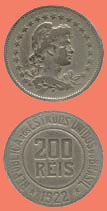 |
Data: |
Quantidade: |
1918
1919
1920
1921
1922
1923
1924
1925
1926
1927
1928
1929
1930
1931
1932
1933
1934
1935 |
625.000
891.000
1.657.000
1.135.000
678.000
1.655.000
1.750.000
2.082.000
324.000
1.806.000
782.000
2.440.000
1.697.000
1.830.000
761.000
173.000
612.000
1.329.000 |
Peso:
Gewicht: 8,00 gr.
Weight: |
400
réis cupro-níquel (75% cobre e 25% níquel), peso 12,00 gr.
Anv: Cabeça de uma
mulher
personificando
Brasil dentro colar de 21
estrelas.
Rev: 400 RÉIS
dentro colar de pérolas. Texto: REPUBLICA DOS ESTADOS UNIDOS DO BRASIL e
data.
400 réis koper-nikkel (75% koper en 25% nikkel), gewicht
12,00 gr.
Vz: Vrouw
voorstellende
Brazilië met 21
sterren om het
hoofd.
Kz: 400 RÉIS in
een cirkel van
parels. Tekst: republiek van de
verenigde staten
van Brazilië en jaartal.
400 réis copper-nickel (75% copper and 25% nickle), weight
12,00 gr.
Obv: Woman
representing Brazil
with 21 stars
around the head.
Rev: 400 RÉIS in a
circle of pearls. Text: republic of the
united states of
Brazil and date. |
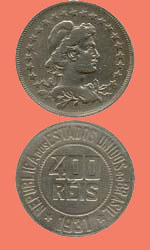 |
Data: |
Quantidade: |
1918
1919
1920
1921
1922
1923
1925
1926
1927
1929
1930
1931
1932
1935 |
491.250
891.000
1.521.000
870.750
1.275.000
764.250
2.047.500
1.033.500
738.000
868.500
1.031.000
1.430.500
587.500
225.000 |
Peso:
Gewicht: 12,00 gr.
Weight: |
500
réis cobre-alumínio (91% cobre e 9% alumínio),
peso 4,00 gr.
Anv: Uma
mulher (abundância) sentada de joelho dentro colar de 21
estrelas.
Rev: O valor 500 réis dentro
florões. Texto: BRASIL e
data.
OBSERVAÇÃO: Existam falsas da epoca com as
datas 1926 e 1929.
500 réis koper-aluminium (91% koper en 9% aluminium),
gewicht 4,00 gr.
Vz: Geknielde
vrouw,
voorstellende
abundantia, binnen
cirkel van 21
sterren.
Kz: De waarde 500 réis
binnen
takkenversiering. Tekst:
Brazilië en datum.
OPMERKING: Er bestaan contemporaine vervalsingen met de jaartallen 1926 en
1929.
500 réis copper-aluminium (91% copper and 9% aluminium),
weight 4,00 gr.
Obv: Knieling
woman,
representing abundantia,
inside circle of 21
stars.
Rev: The value 500 réis
within ornament of
leaves. Text: Brazil and
date.
NOTE: Fakes exist with the dates 1926 and 1929. |
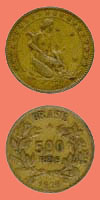 |
Data: |
Quantidade: |
1924
1927
1928
1930
|
7.400.000
2.724.900
9.432.000
146.000 |
Peso:
Gewicht: 4,00 gr.
Weight: |
1000
réis
bronze-alumínio (91% cobre e 9% alumínio),
peso 8,00 gr.
Anv: Uma
mulher (abundância) sentada de
joelho dentro colar de 21
estrelas.
Rev: O valor 1000 réis dentro
florões. Texto: BRASIL e
data.
1000 réis
aluminium-brons (91% koper en 9% aluminium),
gewicht 8,00 gr.
Vz: Geknielde
vrouw,
voorstellende
abundantia, binnen
cirkel van 21
sterren.
Kz: De waarde 1000 réis
binnen
takkenversiering. Tekst:
Brazilië en datum.
1000 réis
aluminium-bronze (91% copper and 9% aluminium),
weight 8,00 gr.
Obv: Knieling
woman,
representing abundantia,
inside circle of 21
stars.
Rev: The value 1000 réis
within ornament of
leaves. Text: Brazil and
date. |
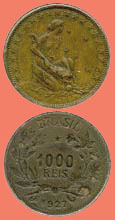 |
Data: |
Quantidade: |
1924
1925
1927
1928
1929
1930
1931
|
9.324.000
6.205.000
35.817.000
1.899.000
83.000
45.000
200.000 |
Peso:
Gewicht: 8,00 gr.
Weight: |
2000
réis prata (50% prata e 50% cobre), peso 8,00 gr,
Anv: Cabeça de uma
mulher
personificando
Brasil dentro colar de 21
estrelas.
Rev: O valor 2000 réis dentro
florões. Texto: REPUBLICA DOS ESTADOS UNIDOS DO BRASIL e data.
2000 réis zilver (50% zilver en 10% koper), gewicht 8,00 gr,
Vz: Vrouwenhoofd
voorstellende
Brazilië, binnen
cirkel van 21
sterren.
Kz: De waarde 2000 réis
binnen
takkenversiering. Tekst:
republiek van de
verenigde staten
van Brazilië.
2000 réis silver (50% silver and 10% copper), weight 8,00 gr,
Obv: Womans
head representing Brazil,
inside circle of 21
stars.
Rev: The value 2000 réis
within ornament of
leaves. Text: republic of the
united states of
Brazil. |
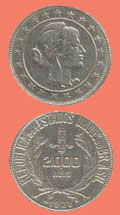 |
Data: |
Quantidade: |
1924
1925
1926
1927
1928
1929
1930
1931
1934 |
9.147.000
723.000
1.787.000
1.009.000
1.250.000
1.744.000
1.240.000
546.000
938.000 |
Peso:
Gewicht: 8,00 gr.
Weight: |







